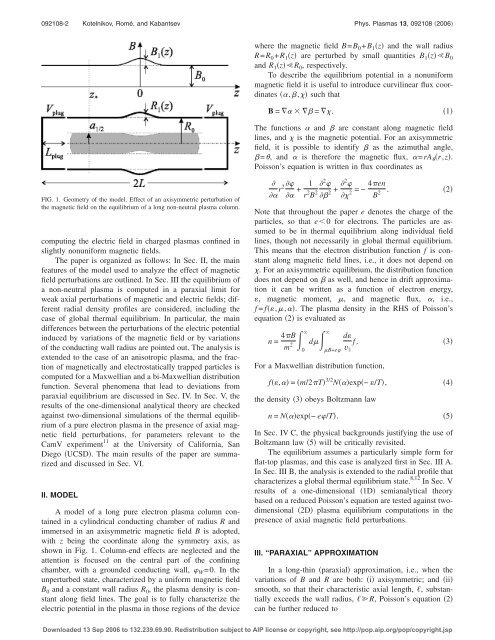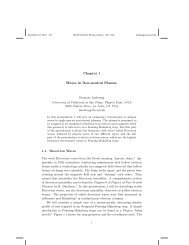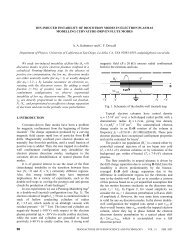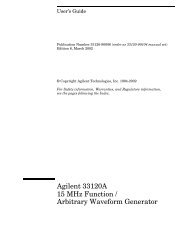Non-neutral plasma equilibria with weak axisymmetric magnetic ...
Non-neutral plasma equilibria with weak axisymmetric magnetic ...
Non-neutral plasma equilibria with weak axisymmetric magnetic ...
Create successful ePaper yourself
Turn your PDF publications into a flip-book with our unique Google optimized e-Paper software.
092108-2 Kotelnikov, Romé, and Kabantsev Phys. Plasmas 13, 092108 2006<br />
where the <strong>magnetic</strong> field B=B 0 +B 1 z and the wall radius<br />
R=R 0 +R 1 z are perturbed by small quantities B 1 zB 0<br />
and R 1 zR 0 , respectively.<br />
To describe the equilibrium potential in a nonuniform<br />
<strong>magnetic</strong> field it is useful to introduce curvilinear flux coordinates<br />
,, such that<br />
B = = .<br />
1<br />
The functions and are constant along <strong>magnetic</strong> field<br />
lines, and is the <strong>magnetic</strong> potential. For an <strong>axisymmetric</strong><br />
field, it is possible to identify as the azimuthal angle,<br />
=, and is therefore the <strong>magnetic</strong> flux, =rA r,z.<br />
Poisson’s equation is written in flux coordinates as<br />
FIG. 1. Geometry of the model. Effect of an <strong>axisymmetric</strong> perturbation of<br />
the <strong>magnetic</strong> field on the equilibrium of a long non-<strong>neutral</strong> <strong>plasma</strong> column.<br />
computing the electric field in charged <strong>plasma</strong>s confined in<br />
slightly nonuniform <strong>magnetic</strong> fields.<br />
The paper is organized as follows: In Sec. II, the main<br />
features of the model used to analyze the effect of <strong>magnetic</strong><br />
field perturbations are outlined. In Sec. III the equilibrium of<br />
a non-<strong>neutral</strong> <strong>plasma</strong> is computed in a paraxial limit for<br />
<strong>weak</strong> axial perturbations of <strong>magnetic</strong> and electric fields; different<br />
radial density profiles are considered, including the<br />
case of global thermal equilibrium. In particular, the main<br />
differences between the perturbations of the electric potential<br />
induced by variations of the <strong>magnetic</strong> field or by variations<br />
of the conducting wall radius are pointed out. The analysis is<br />
extended to the case of an anisotropic <strong>plasma</strong>, and the fraction<br />
of <strong>magnetic</strong>ally and electrostatically trapped particles is<br />
computed for a Maxwellian and a bi-Maxwellian distribution<br />
function. Several phenomena that lead to deviations from<br />
paraxial equilibrium are discussed in Sec. IV. In Sec. V, the<br />
results of the one-dimensional analytical theory are checked<br />
against two-dimensional simulations of the thermal equilibrium<br />
of a pure electron <strong>plasma</strong> in the presence of axial <strong>magnetic</strong><br />
field perturbations, for parameters relevant to the<br />
CamV experiment 11 at the University of California, San<br />
Diego UCSD. The main results of the paper are summarized<br />
and discussed in Sec. VI.<br />
II. MODEL<br />
A model of a long pure electron <strong>plasma</strong> column contained<br />
in a cylindrical conducting chamber of radius R and<br />
immersed in an <strong>axisymmetric</strong> <strong>magnetic</strong> field B is adopted,<br />
<strong>with</strong> z being the coordinate along the symmetry axis, as<br />
shown in Fig. 1. Column-end effects are neglected and the<br />
attention is focused on the central part of the confining<br />
chamber, <strong>with</strong> a grounded conducting wall, W =0.Inthe<br />
unperturbed state, characterized by a uniform <strong>magnetic</strong> field<br />
B 0 and a constant wall radius R 0 , the <strong>plasma</strong> density is constant<br />
along field lines. The goal is to fully characterize the<br />
electric potential in the <strong>plasma</strong> in those regions of the device<br />
<br />
r2 + 1<br />
r 2 B 2 2 <br />
2 + 2 <br />
2 =−4en B 2 . 2<br />
Note that throughout the paper e denotes the charge of the<br />
particles, so that e0 for electrons. The particles are assumed<br />
to be in thermal equilibrium along individual field<br />
lines, though not necessarily in global thermal equilibrium.<br />
This means that the electron distribution function f is constant<br />
along <strong>magnetic</strong> field lines, i.e., it does not depend on<br />
. For an <strong>axisymmetric</strong> equilibrium, the distribution function<br />
does not depend on as well, and hence in drift approximation<br />
it can be written as a function of electron energy,<br />
, <strong>magnetic</strong> moment, , and <strong>magnetic</strong> flux, , i.e.,<br />
f = f,,. The <strong>plasma</strong> density in the RHS of Poisson’s<br />
equation 2 is evaluated as<br />
n = 4B <br />
m 2 0<br />
<br />
dB+e<br />
d<br />
v <br />
f .<br />
For a Maxwellian distribution function,<br />
f, = m/2T 3/2 Nexp− /T,<br />
the density 3 obeys Boltzmann law<br />
n = Nexp− e/T.<br />
In Sec. IV C, the physical backgrounds justifying the use of<br />
Boltzmann law 5 will be critically revisited.<br />
The equilibrium assumes a particularly simple form for<br />
flat-top <strong>plasma</strong>s, and this case is analyzed first in Sec. III A.<br />
In Sec. III B, the analysis is extended to the radial profile that<br />
characterizes a global thermal equilibrium state. 8,12 In Sec. V<br />
results of a one-dimensional 1D semianalytical theory<br />
based on a reduced Poisson’s equation are tested against twodimensional<br />
2D <strong>plasma</strong> equilibrium computations in the<br />
presence of axial <strong>magnetic</strong> field perturbations.<br />
III. “PARAXIAL” APPROXIMATION<br />
In a long-thin paraxial approximation, i.e., when the<br />
variations of B and R are both: i <strong>axisymmetric</strong>; and ii<br />
smooth, so that their characteristic axial length, , substantially<br />
exceeds the wall radius, R, Poisson’s equation 2<br />
can be further reduced to<br />
3<br />
4<br />
5<br />
Downloaded 13 Sep 2006 to 132.239.69.90. Redistribution subject to AIP license or copyright, see http://pop.aip.org/pop/copyright.jsp








![WORKSHOP PARTICIPANTS LIST [pdf] - UC San Diego](https://img.yumpu.com/35298899/1/190x245/workshop-participants-list-pdf-uc-san-diego.jpg?quality=85)
